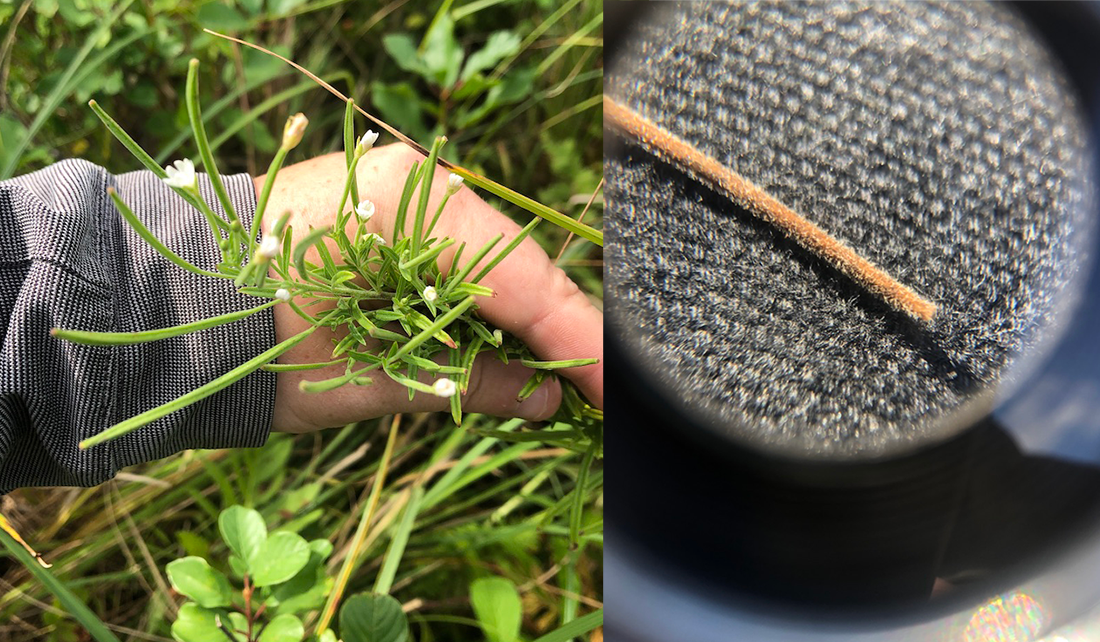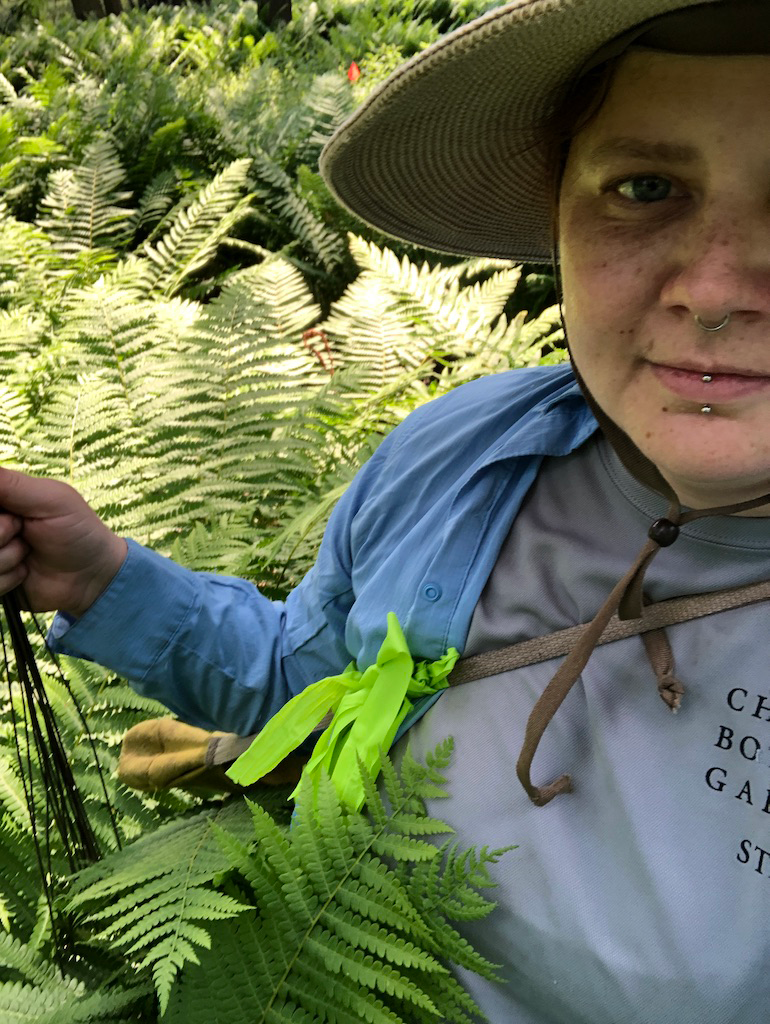
“Meet Our Grad Student Scholars” is an article series from Illinois-Indiana Sea Grant (IISG) celebrating the graduate students doing research funded by the IISG scholars program. To learn more about our faculty and graduate student funding opportunities, visit our Fellowships & Scholarships page.
Alexandra (Ali) Touloupas is a master’s student in Plant Biology and Conservation joint program with Northwestern University and the Chicago Botanic Garden, and is part of the inaugural Illinois-Indiana Sea Grant Graduate Student Scholars cohort. She is interested in rare plant conservation and the impacts of climate change on bog and fen species. Her work involves monitoring and modeling rare plant distributions, and how critical habitat may be impacted by climate change. Ali has earned two bachelor’s degrees, learning about Plant Biology from North Carolina State University and Sociology from Mount Holyoke College. Ali enjoys hiking and exploring new natural areas, and stopping in antique stores along the way.
As a master’s student and scientist who studies rare plant species, Alexandra (Ali) Touloupas has partnered with the Chicago Botanic Garden to record current populations and predict how rare plant species may respond to climate change. This project has many components, some of which require Touloupas to survey rare species, model habitat suitability, calculate statistical predictions, and predict future climate scenarios in wetlands.
The rare plants Touloupas studies are considered high priority species. These species were chosen by expert ecologists and botanists because more data is needed to update their conservation status. Last year, she worked as a research assistant for the Plants of Concern program at Chicago Botanic Garden, coordinating and conducting rare plant monitoring throughout Cook County during the field season. In late fall, she analyzed annual monitoring data to detect population trends. This position helped Touloupas understand the potential impact of her work on rare plant monitoring initiatives.
A typical research day for her depends on the season. In the summer, she does a lot of hands-on field work and sometimes turns into a modern-day Sherlock Holmes to find a specific plant. According to Touloupas, the detective work that goes into determining the locations of rare species is sometimes daunting but always fun. First, she looks for the last known coordinates of her species by accessing records from the Illinois Natural Heritage website. The data and coordinates can only be accessed through a confidentiality agreement to protect rare plants and their habitats from trampling and poaching. Then, she uses a GPS to get herself to the location. This can be tricky for a few reasons; bogs and wetlands are hard to move through, even when someone knows where they are going. And while getting stuck in the muck with boots sinking into the ground, Touloupas must be careful not to disturb the fragile habitat.

Using a hand lens is crucial to see the dense hairs that distinguish this species that Touloupas is studying, Epilobium strictum, from other species. (Photo provided by Alexandra Touloupas)
Last summer, she drove long distances to get to field locations and sometimes even camped overnight near the sites. The plants she is focused on live in bogs and fens—wetlands that accumulate lots of peat and runoff. Certain indicator species, which have adapted to the harsh conditions, help Touloupas know she is getting closer to her rare plants… or at least where they used to be. Some of the species she hunts for were last seen 50 years ago, so she never knows what she will find.

Sometimes Ali has to wade through ferns and other flora nearly as tall as she is when looking for rare species, as shown here during field work for Chicago Botanic Garden’s Plants of Concern program. (Photo provided by Alexandra Touloupas)
A lot can happen over 50 years, including immense ecological changes. For example, cattails take over what was once a diverse bog, or an invasive animal could eat a whole population of plants. When Touloupas finds a rare plant species, she takes their new GPS coordinates as well as detailed notes and photos. Nothing is too small to be observed. She notes if plants are growing on a slope, in shade or sun, and especially looks for things that might not allow for long-term survival. Because ecological landscapes are always changing, she also takes note of small signs that indicate what might become of the sites, particularly if new bogs and fens are forming.
The next phase of Touloupas’ research is to process the data she collected during her fieldwork. She plans to incorporate the spatial data she collected about rare plants into possible climate change scenarios. Since climate change is so complex, Touloupas must compile scenarios with many different variables. She chose to include temperature and precipitation, soil type and soil characteristics, acidity of soil, and relationships to geology and glaciers. To understand conditions that enable her species to persist, Touloupas uses information from GIS datasets and remote sensing images. Land use will also be factored into the scenarios, including distances from developments that may produce harmful runoff, because wetlands are particularly sensitive to pollutants. Ultimately, Touloupas plants to contextualize her findings in various climate scenarios, like those created by the Intergovernmental Panel on Climate Change.
One of her proudest accomplishments is learning how to process data with the R coding language. She is using GIS mapping and R to model possible futures for her rare plants. To do this, she uses statistical analysis and strategic model selection. When she has combined all her results together, Touloupas plans to share best practices with organizations that want to conserve rare plants, such as suggesting sites where the plants could be reintroduced.
When she started graduate school, Touloupas thought of it as a career move and personal milestone that would secure an appealing job. After some time at Northwestern, she was surprised to find that graduate school itself is lots of fun. Being back in academia, around other people doing research and learning from their processes, has inspired her to dig into the field. She is particularly thankful for the support for her own research. She feels more empowered to do plant biology work and is even considering more research in the future.
To any aspiring plant scientists, Touloupas recommends gaining experience by working seasonal jobs or completing internships to test different roles and find something inspiring. “Find what you like and what works best for you,” she said. “Listen to podcasts and lectures, either in person or online, to get inspired by other people’s research and to see what’s possible. There is a lot of creativity that goes into designing a research project.”
Touloupas learned about the rare plants she is studying by taking classes during the first part of her degree. The graduate-level courses involved plenty of literature reviews, through which she learned about the latest research in plant biology. Additionally, folx who have worked in the areas for decades took students into the field to share their data collection processes and tips. She also tried to absorb all the information she could through books like “A Great Lakes Wetland Flora” and a few key organizations. The Illinois Wildflowers website, US Department of Agriculture and Illinois Natural History Survey resources were particularly helpful. Touloupas hopes that the final results of her study will end up help in one of these public resources.
You can learn more about the exciting research that Ali is conducting at Northwestern University by following @aktouloupas on Twitter and big_al_botany on Instagram.
Illinois-Indiana Sea Grant is a part of University of Illinois Extension and Purdue Extension.
Writer: Sarah Gediman
Contact: Carolyn Foley

